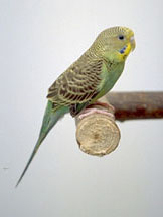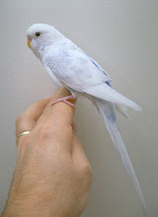Budgies - General
General Information
The budgerigar (Melopsittacus undulates), also referred to as a parakeet or more commonly a budgie, is perhaps the most popular pet bird worldwide. This beautiful, small bird originates from the drier regions of Australia. Escaped budgies are currently establishing themselves as an introduced population in Florida, USA. Their natural habitat is dry open plains, wood lots bordering waterways, and sparsely wooded grasslands.
"Budgies are generally very social, gentle, and affectionate in nature."
Budgies are generally very social, gentle, and affectionate in nature. These loving companions interact well with most members of the family. Budgies are inquisitive, active, free spirits who enjoy flying, playing, and chewing. Non-toxic, pet-safe toys should be provided for your budgie's entertainment. Although their voices are not as clear as some of the larger parrots, budgies have the capacity to develop extensive vocabularies. Talking or mimicking requires some effort and training. Males seem to talk better than females, although both are capable. One endearing trait of a budgie is its cheerful whistling and chatter. Budgies can be finger trained, and some even enjoy head scratches and petting.
Purchasing a Budgie
"Young birds may be easier to tame and train, and adapt readily to environments and situations."
Budgies may be purchased from a pet store, a reputable breeder, or adopted from numerous rescue sites. Young budgies may be easier to tame and train, and adapt readily to new environments and situations. Older, wild, colony, or parent-raised birds may prove more challenging to tame. Hand-raised babies may make better pets, since they have been completely socialized with humans. New birds should be exposed early to different events (young and old people, males and females, other pets, car trips, visits to the veterinarian, etc.) to help make them calmer and better adjusted. A lively, alert bird that is not easily frightened is more likely to be a healthy bird. After you obtain a new bird, you should have it examined by a veterinarian familiar with birds.
Veterinary Care
Budgies require regular, routine veterinary health check-ups. Your veterinarian can perform a physical examination, grooming (beak, nail, or feather trim as necessary), and laboratory tests as needed. During these semi-annual check-ups, health, nutritional, and maintenance issues can be identified and addressed. Veterinary check-ups help prevent disease and will aid in the maintenance of a long lasting, healthy relationship between you and your bird.
Color
Mature
The mature wild budgie has a green body with yellow on the face. Black and yellow barring (stripes) is found on the inside of the wings and on the top of the head, and black spots appear across the throat.
Domestic varieties show infinite combinations and shades of green, yellow, blue, mauve, slate, and white.
Both wild and domestic budgies have gray/blue skin on their legs that is scaly like reptiles’ skin.
Immature
Immature budgies have a duller feather color, black barring on their foreheads that extends down to the cere (featherless area on the beak around the nostrils), and they may or may not have black spots on the throat area.
Sexing
Mature
Feathering patterns between sexes are similar. The male's cere is rich blue in color. The female's cere is pink or brown and sometimes crusty in the breeding female from the effects of estrogen. Cere color may not always identify the sexes 100% and may vary with domestic color variations.
Immature
Difficult to sex.
General characteristics
Weight: Average is 1.0 - 1.2 ounces (30 - 35 grams), large varieties (such as the popular English budgerigar) are 1.2 - 1.6 ounces (35 - 45 grams).
Size: Average is 7 - 7.5 inches (18 - 19 cm) in length.
Life-span: Average is 6 - 10 years (have been reported to live as long as 18 years).
Diet: Pelleted diets formulated for birds should make up at least 2/3 of the diet with supplemental fresh vegetables and fruit (and very limited seed) as the other 1/3. Consult your veterinarian for specific recommendations for your bird.
Breeding: Sexually mature at six months old. Budgies are gregarious birds that breed best if several pairs are kept within sight and sound of each other. Budgies in the wild breed in the spring, but most will easily breed in captivity at any time of year.
Brood Size: Three to six white eggs will hatch in 18 days, on average; young leave the nest in four to five weeks.
Cage: Minimum size per bird is 1 ft wide x 1 ft high x 2 ft long (30 cm x 30 cm x 60 cm). Larger sizes are generally preferred and must be provided to house more than one bird in a cage.






